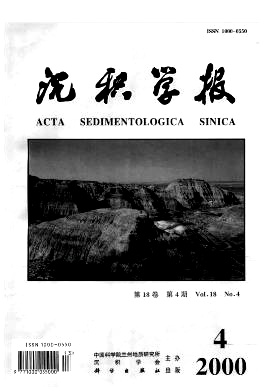DING Xiao zhong, LIU Xun, WU Shao zu, FU De rong, YAO Jian xin, WANG Yong, YAN Yi. The Finding and Significance of Early Permian Trace Fossils of Deep water in the Northwest Margin of Tarim Plate[J]. Acta Sedimentologica Sinica, 2000, 18(4): 495-500.
| Citation:
|
DING Xiao zhong, LIU Xun, WU Shao zu, FU De rong, YAO Jian xin, WANG Yong, YAN Yi. The Finding and Significance of Early Permian Trace Fossils of Deep water in the Northwest Margin of Tarim Plate[J]. Acta Sedimentologica Sinica, 2000, 18(4): 495-500.
|
The Finding and Significance of Early Permian Trace Fossils of Deep water in the Northwest Margin of Tarim Plate
- Received Date: 1999-08-06
- Rev Recd Date:
2000-02-18
- Publish Date:
2000-08-10
-
Abstract
A huge amount of trace fossils have been found for the first time in the middle part of the Lower Permian Biyoulety Group in the northwest margin of Tarim plate,and they are Glockeria Ksiazkiewicz1968,Helminthoida sp.,Megagrapton sp.,Paleodictyon sp.,Paleodictyon(Glenodictyum)Croaticum Ulchman1995,Planolites sp.,Protopaleodictyon sp.,Scalaritubamissouriensis Weller1899,Spirophycus sp. et al.According to the analysis of the behavior types of organisms and the features of ethological environment,these trace fossils mainly contain the deep-sea Fodinichnia,Pascichnia and Agrichnia,lack of Domichnia,Cubichnia and Repichnia et al that were usually found in shallow water.This trace fossil assemblage reflects the characteristics of behavior types of organisms in deep-sea environment and is interpreted to represent a typical deep-sea Nereites ichnofacies. Based on the research of Unggur section(Wuqia County),the lower part of the Biyoulety Group is composed of mudy limestone,silty mudstone,siltstone and limestone of neritic shelf facies;while its middle part is made up turbidite deposits with silicilith intercalated in the deep-sea fan that contained the abundant trace fossils of Nereites ichnofacies;the upper part of the Biyoulety Group is dominantly composed of siliceous limestone,limestone,sandy limestone,silty mudstone and calcareous sandstone of neritic shelf-littoral facies.Through the related water-depth analysis of shape types,behavior habits and characteristics of trace fossils in this area,we can conclude that these trace fossil associations found in this area are different in each part of turbiditic fan that formed different sedimentary environments from distal area(outer fan) to proximal area(inner fan) of turbidity fan. 1) The trace fossil association produced by both organism feeding and semi-dwelling mainly occurs in inner fan.Such as Glockeria(Fodinichnia),it was formed by the radial feeding in the vertical burrows that the organism dwelled and feeded and generated at the shallower depths(200-1 300m),and the water energy was higher condition in this environment and disadvantageous for the organism living on the depositional surface. Pascichnia and Agrichnia were not found here,while a lot of "spanning facies" type members- Planolites co-occurred. 2) The Pascichnia of horizontal curve,snake and spiral shapes and Fodinichnia with the backfill structure appear in the middle fan.Such as Scalarituba and Spirophycus,lack of "spanning facies" type members here. 3) The association of trace fossils in the outer fan is characterized by the large appearance of network shape Agrichnia and regular snake-shaped Pascichnia,the radial Fodinichnia are not found in this environment.The Pascichnia in this association also appearred as regular habits and characteristics of gnawing for food.The trace fossils of deep-water types are of absolutely predominant role in quantity,for example: Helminthoida,Paleodictyon and Megagrapton and so on.The water depths at which this association of trace fossils formed below sea-level concentrated from 600m(800m) to 2 000m,and they are of higher abundance and degree and horizontally preserved on the surface of rock strata. In addition, the Biyoulety Group distributed over Bayankurut area(northwest of Unggur,Wuqia County) is a typical thick turbidite composed of greyish green thin slate,black sandy limestone and mudstone.The turbidite is of typical Bouma sequence that mainly developed D and E beddings and also the flute cast that indicates the ancient current direction about 300°±.A lot of deep-water trace fossils,such as Protopaleodictyon sp. and so on,were found in this strata and of the distribution characteristics of large scale snake shape,and also were the important ichnofossils of Nereites ichnofacies.Linking the sedimentary feature and environment analysis of the host rocks of trace fossils,we can infer this area also reached the deep-sea ri
-
References
|
[1]
|
新疆地质矿产局地质矿产研究所,中国地质科学院地质研究所.新疆柯坪地区石炭系、二叠系及其生物群[M].北京:海洋出版社,1987.101~114 |
|
[2]
|
Seilacher A. Bathymetryof trace fossils[J]. Mar. Geol., 1967, 5:189.~200,413~428 |
|
[3]
|
杨式溥.青海果洛、玉树地区二叠纪和三叠纪复理石相遗迹化石[J].沉积学报,1988,6(1):1~11 |
|
[4]
|
晋慧娟,李育慈.准噶尔盆地晚古生代深水斜坡沉积中遗迹相及其环境分析[J].中国科学(B)辑,1991,21(4):408~415 |
|
[5]
|
晋慧娟,李育慈.西秦岭二叠纪-三叠纪遗迹化石及其环境意义[J].地质科学,1995,30(4):321~328 |
|
[6]
|
杨式溥.古遗迹学[M].北京:地质出版社,1990 |
|
[7]
|
Crimes T P. Trace fossils of an Eocene deep-sea sand fan, Norhten Spain[A]. In:Crimes T P,Harper J C,eds. Trace Fossils Ⅱ [C]. Geol. Jour. Spec. Issue 9:71~90 |
|
[8]
|
李育慈,晋慧娟.西秦岭北带泥盆系中的遗迹化石及其环境意义[J].中国科学(B辑),1993,23(12):1322~1328 |
|
[9]
|
丁孝忠,刘训,吴绍祖等.塔里木板块西北缘石炭纪层序地层及相对海平面变化探讨[J].中国区域地质,2000,19(1):58~65. |
-
-
Proportional views

-






 DownLoad:
DownLoad: